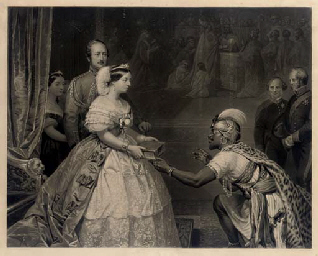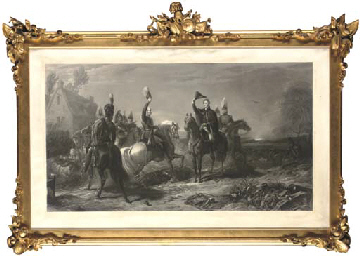After THOMAS JONES BARKER [The Relief of Lucknow, & triumphant meeting of Havelock, Outram, Sir Colin Campbell November 1857] large mixed method engraving by Charles George Lewis coloured by hand, [published March 25 1862 by Thos. Agnew & Sons, Manchester, Liverpool & London], (sight size: 630 x 1210mm), framed and glazed, unexamined out of frame (cut to edge of image, a few small areas of discoluration, title panel mounted onto backing board). The Indian Mutiny in 1857 was the first sign of disaffection against British rule. It erupted at Meerut, near Delhi, and spread rapidly across North India. At Lucknow, the European and Christian population retired into the heavily fortified British residency, guarded by a small force of loyal sepoys. Finally, in mid-November, Colin Campbell Commander-in-Chief, conducted the exhausted garrison out of the city. It was not finally re-occupied until March 1858. The defence and relief of the Lucknow Residency became, understandably, a famous episode in British military annals. The subject of Thomas Jones Barker's oil painting, in the National Gallery, London, is the encounter between the three most popular heroes of the campaign, Colin Campbell James Outram, and General Sir Henry Havelock. Barker (1815-1882), the son of "Barker of Bath", was a popular painter of military subjects and battle scenes. Lewis (1808-80), the son of Frederick Christian Lewis was a prolific engraver, widely known for his numerous plates after the works of Edwin Landseer
After THOMAS JONES BARKER [The Relief of Lucknow, & triumphant meeting of Havelock, Outram, Sir Colin Campbell November 1857] large mixed method engraving by Charles George Lewis coloured by hand, [published March 25 1862 by Thos. Agnew & Sons, Manchester, Liverpool & London], (sight size: 630 x 1210mm), framed and glazed, unexamined out of frame (cut to edge of image, a few small areas of discoluration, title panel mounted onto backing board). The Indian Mutiny in 1857 was the first sign of disaffection against British rule. It erupted at Meerut, near Delhi, and spread rapidly across North India. At Lucknow, the European and Christian population retired into the heavily fortified British residency, guarded by a small force of loyal sepoys. Finally, in mid-November, Colin Campbell Commander-in-Chief, conducted the exhausted garrison out of the city. It was not finally re-occupied until March 1858. The defence and relief of the Lucknow Residency became, understandably, a famous episode in British military annals. The subject of Thomas Jones Barker's oil painting, in the National Gallery, London, is the encounter between the three most popular heroes of the campaign, Colin Campbell James Outram, and General Sir Henry Havelock. Barker (1815-1882), the son of "Barker of Bath", was a popular painter of military subjects and battle scenes. Lewis (1808-80), the son of Frederick Christian Lewis was a prolific engraver, widely known for his numerous plates after the works of Edwin Landseer















Testen Sie LotSearch und seine Premium-Features 7 Tage - ohne Kosten!
Lassen Sie sich automatisch über neue Objekte in kommenden Auktionen benachrichtigen.
Suchauftrag anlegen